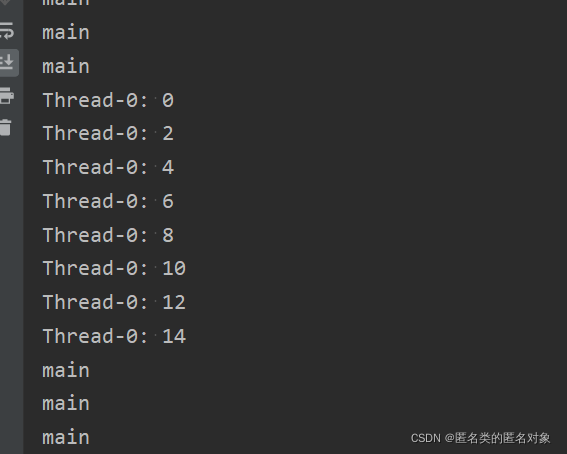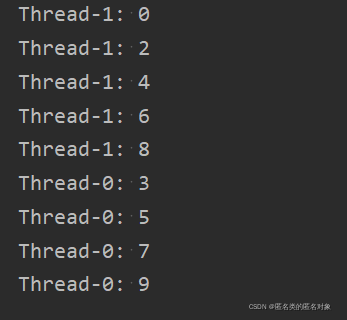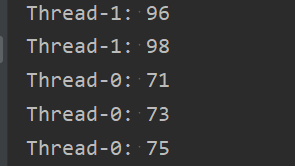目录
面试题:Java中多线程的创建有几种方式?四种。
方式一:继承Thread类的方式:
-
- 创建一个继承于Thread类的子类
-
- 重写Thread类的run() --> 将此线程执行的操作声明在run()中
-
- 创建Thread类的子类的对象
-
- 通过此对象调用start():start()作用①启动当前线程 ② 调用当前线程的run()
输出100以内的偶数
//1. 创建一个继承于Thread类的子类
class MyThread extends Thread {
// 2. 重写Thread类的run() --> 将此线程执行的操作声明在run()中
@Override
public void run() {
for (int i = 0; i < 100; i++) {
if (i % 2 == 0) {
System.out.println(Thread.currentThread().getName() + ": " + i);
}
}
}
}
//线程测试类
public class ThreadTest {
public static void main(String[] args) {
//3. 创建Thread类的子类的对象
MyThread myThread = new MyThread();
//4. 通过此对象调用start():start()作用①启动当前线程 ② 调用当前线程的run()
myThread.start();
for (int i = 0; i < 100; i++) {
System.out.println(Thread.currentThread().getName());
}
}
}
输出结果

可以看到创建了一个线程输出0-100的偶数,主线程输出100次线程名,两个线程出现交互,每次运行结果都不一样。如果调用myThread.run()则没有创建线程,只是main线程调用了方法。
创建两个线程,一个输出奇数,一个输出偶数
方法一、创建两个子线程,分别调用run()
public class ThreadTest {
public static void main(String[] args) {
MyThread1 myThread1 = new MyThread1();
MyThread2 myThread2 = new MyThread2();
myThread1.start();
myThread2.start();
}
}
class MyThread1 extends Thread {
@Override
public void run() {
for (int i = 0; i < 10; i++) {
if (i % 2 == 1) {
System.out.println(Thread.currentThread().getName() + ": " + i);
}
}
}
}
class MyThread2 extends Thread {
@Override
public void run() {
for (int i = 0; i < 10; i++) {
if (i % 2 == 0) {
System.out.println(Thread.currentThread().getName() + ": " + i);
}
}
}
}

方法二、使用匿名内部类
public class ThreadTest {
public static void main(String[] args) {
new Thread() {
@Override
public void run() {
for (int i = 0; i < 100; i++) {
if (i % 2 == 1) {
System.out.println(Thread.currentThread().getName() + ": " + i);
}
}
}
}.start();
new Thread() {
@Override
public void run() {
for (int i = 0; i < 100; i++) {
if (i % 2 == 0) {
System.out.println(Thread.currentThread().getName() + ": " + i);
}
}
}
}.start();
}
}

说明两个问题
问题一:我们启动一个线程,必须调用start(),不能调用run()的方式启动线程。
问题二:如果再启动一个线程,必须重新创建一个Thread子类的对象,调用此对象的start().
方式二:实现Runnable接口的方式:
-
- 创建一个实现了Runnable接口的类
-
- 实现类去实现Runnable中的抽象方法:run()
-
- 创建实现类的对象
-
- 将此对象作为参数传递到Thread类的构造器中,创建Thread类的对象
-
- 通过Thread类的对象调用start()
//例子,输出10以内的偶数
- 通过Thread类的对象调用start()
// 1. 创建一个实现了Runnable接口的类
class MyThread implements Runnable {
//2. 实现类去实现Runnable中的抽象方法:run()
@Override
public void run() {
for (int i = 0; i < 10; i++) {
System.out.println(Thread.currentThread().getName() + "-" + i);
}
}
}
public class ThreadTest {
public static void main(String[] args) {
//3. 创建实现类的对象
MyThread myThread = new MyThread();
//4. 将此对象作为参数传递到Thread类的构造器中,创建Thread类的对象
Thread thread = new Thread(myThread);
//5. 通过Thread类的对象调用start()
thread.start();
}
}
两种方式的对比:
- 开发中:优先选择:实现Runnable接口的方式
- 原因:1. 实现的方式没类的单继承性的局限性
-
2. 实现的方式更适合来处理多个线程共享数据的情况。 - 联系:public class Thread implements Runnable
- 相同点:两种方式都需要重写run(),将线程要执行的逻辑声明在run()中。
目前两种方式,要想启动线程,都是调用的Thread类中的start()。
JDK5.0新增线程创建的方式
新增方式一:实现Callable接口。
— JDK 5.0新增
//1.创建一个实现Callable的实现类
class NumThread implements Callable{
//2.实现call方法,将此线程需要执行的操作声明在call()中
@Override
public Object call() throws Exception {
int sum = 0;
for (int i = 1; i <= 100; i++) {
if(i % 2 == 0){
System.out.println(i);
sum += i;
}
}
return sum;
}
}
public class ThreadNew {
public static void main(String[] args) {
//3.创建Callable接口实现类的对象
NumThread numThread = new NumThread();
//4.将此Callable接口实现类的对象作为传递到FutureTask构造器中,创建FutureTask的对象
FutureTask futureTask = new FutureTask(numThread);
//5.将FutureTask的对象作为参数传递到Thread类的构造器中,创建Thread对象,并调用start()
new Thread(futureTask).start();
try {
//6.获取Callable中call方法的返回值
//get()返回值即为FutureTask构造器参数Callable实现类重写的call()的返回值。
Object sum = futureTask.get();
System.out.println("总和为:" + sum);
} catch (InterruptedException e) {
e.printStackTrace();
} catch (ExecutionException e) {
e.printStackTrace();
}
}
}
说明:
- 如何理解实现Callable接口的方式创建多线程比实现Runnable接口创建多线程方式强大?
-
- call()可以返回值的。
-
- call()可以抛出异常,被外面的操作捕获,获取异常的信息
-
- Callable是支持泛型的
新增方式二:使用线程池
背景:经常创建和销毁、使用量特别大的资源,比如并发情况下的线程,对性能影响很大。
思路:提前创建好多个线程,放入线程池中,使用时直接获取,使用完放回池中。可以避免频繁创建销毁、实现重复利用。类似生活中的公共交通工具。
class NumberThread implements Runnable{
@Override
public void run() {
for(int i = 0;i <= 100;i++){
if(i % 2 == 0){
System.out.println(Thread.currentThread().getName() + ": " + i);
}
}
}
}
class NumberThread1 implements Runnable{
@Override
public void run() {
for(int i = 0;i <= 100;i++){
if(i % 2 != 0){
System.out.println(Thread.currentThread().getName() + ": " + i);
}
}
}
}
public class ThreadPool {
public static void main(String[] args) {
//1. 提供指定线程数量的线程池
ExecutorService service = Executors.newFixedThreadPool(10);
ThreadPoolExecutor service1 = (ThreadPoolExecutor) service;
//设置线程池的属性
// System.out.println(service.getClass());
// service1.setCorePoolSize(15);
// service1.setKeepAliveTime();
//2.执行指定的线程的操作。需要提供实现Runnable接口或Callable接口实现类的对象
service.execute(new NumberThread());//适合适用于Runnable
service.execute(new NumberThread1());//适合适用于Runnable
// service.submit(Callable callable);//适合使用于Callable
//3.关闭连接池
service.shutdown();
}
}
说明:
- 好处:
- 1.提高响应速度(减少了创建新线程的时间)
- 2.降低资源消耗(重复利用线程池中线程,不需要每次都创建)
- 3.便于线程管理
-
corePoolSize:核心池的大小 -
maximumPoolSize:最大线程数 -
keepAliveTime:线程没任务时最多保持多长时间后会终止